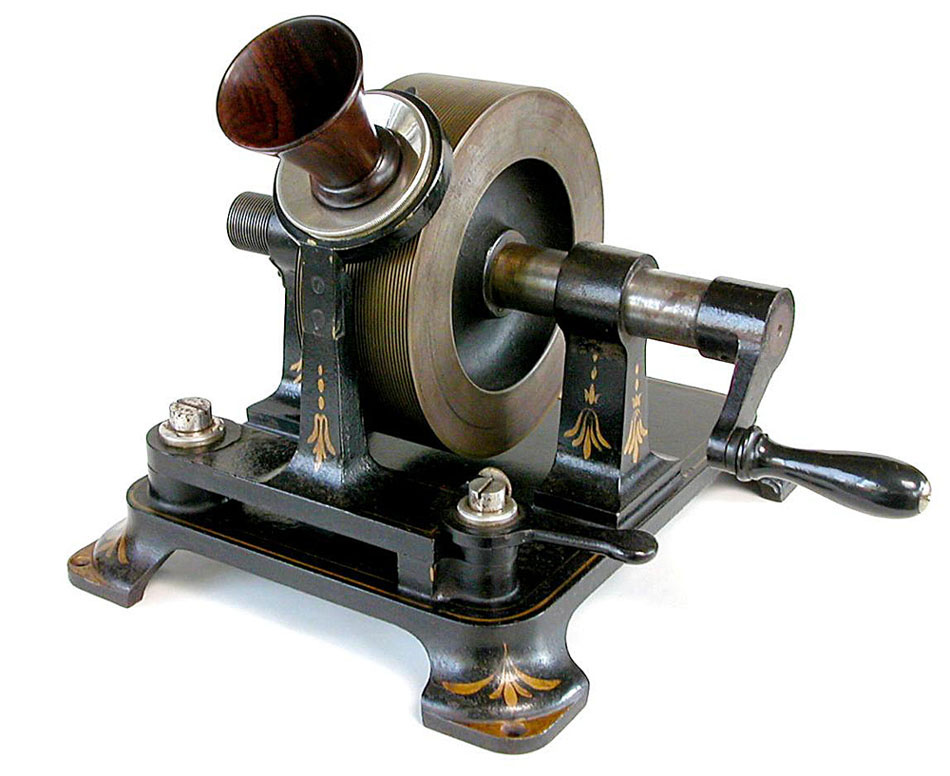ORIGINAL EDISON DEMONSTRATION
TINFOIL PHONOGRAPH BY
E. HARDY - 1878

This is a very historically significant phonograph -- the first ever offered
for sale to the general public. Immediately after the invention of the phonograph
in December 1877 (the first Kruesi prototype) Thomas Edison was bombarded with inquiries
from around the world. People were eager to see and hear this incredible machine,
however public exhibitions would not start until late spring. To help satisfy the
overwhelming curiosity, on January 8, 1878 Edison sketched a design for a small "demonstration"
phonograph which would illustrate the principle of the phonograph, but would not be suitable for public exhibitions (and therefore would not compete with authorized exhibitors).

Several prototypes were built in Edison's laboratory. On February 27, 1878, one was
shipped to Edison's European agent with instructions to have such phonographs made
for sale at the International Exposition in Paris, starting in May. Edison subsequently
contracted with machinist Edouard Hardy (not Edme, as his first name was mistakenly reported for many years) to manufacture these phonographs under Edison's
name. (Hardy was already making Edison's Electric Pen for the European market.) It is not known exactly when the first Hardy demonstration tinfoil phonographs were ready for sale, but a reference in the May 9, 1878 Paris Advertiser, an English-language newspaper, indicated that Edison's
phonograph was "having a great success in society circles at Paris." Since no other Edison phonographs are known to have been exhibited there at the time, this reference presumably confirms that sales started by early May. A few months later Sigmund Bergmann was hired to make similar machines in the
US.
The Hardy-made Edison phonograph is a small but heavy machine, measuring only
about 8" by 10" but weighing 21 pounds. The mandrel is nearly 6" in
diameter but only 2" wide, capable of recording only 50-60 words. The diameter
and weight of the mandrel helped smooth the rotation, making it unnecessary to add
a separate flywheel (and reducing production cost).
Edison's agent described
the Hardy phonograph in a letter written July 17, 1878, saying that "there is
at present but one model of phonograph for sale.... Although this instrument is perfectly
large enough to demonstrate the principle of the invention to satisfaction, yet it
is hardly fit for public exhibition. A special instrument has been constructed for
this purpose." At 200 Francs ($40), equivalent to nearly a month's salary for an average worker,
the "demonstration" phonograph was a very expensive and impractical novelty. The Bergmann-built version was even less successful, and Edison soon dropped the
idea of marketing phonographs to private individuals. Throughout the rest of 1878
the Edison Speaking Phonograph Company concentrated on public exhibitions. It was
not until early 1879, after interest in exhibitions began to wane, that Edison again
began marketing phonographs to the public in the form of the Edison
Parlor Phonograph.

Original engraving of a Hardy tinfoil phonograph from an era catalog by
Charles Magne of Paris, a dealer in electrical and scientific items. This is the only known contemporary engraving of a Hardy tinfoil. The catalog is undated but it lists the Hardy-made Edison tinfoil at 125F, a sharp discount off of the original 200F price, so presumably he was liquidating stock that remained unsold after the Paris Exposition ended. Hardy himself advertised phonographs for sale directly from his workshop as late as 1880 (below).

(RETURN TO MAIN PHONOGRAPH PAGE)




